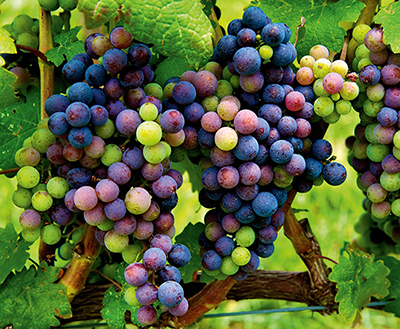
Grapes can be trained to grow over a pergola or along wires.
Fruit vines such as grapes, passionfruit and kiwi fruit don’t take up much space and are easy to grow. Train them up a trellis, against a sunny fence or wall, or over a pergola.
The first cultivation of grapevines began some 6,000 to 8,000 years ago in the Middle East. Grapes grow best in regions with hot, dry summers, cool-to-mild winters, low humidity and moderate annual rainfall, mostly in the cooler months.
• Choose a variety suited to your area. Popular cold-tolerant, short-season seedless varieties include Canadice, Reliance and Marquis. Another favorite is Concord Seedless for its traditional grape flavor, disease resistance and vigor.
• Plant grapevines between late autumn and early spring, making sure that the graft point is about 11/2 inches (4 cm) above the level of the soil.
• Water well from late winter through to harvest time, but avoid wetting the leaves and fruit to help prevent fungal diseases.
• To get plump, perfectly shaped table grapes, thin out the bunches when the fruit first appears by removing damaged, diseased or misshapen grapes with nail scissors.
• Before grapes ripen, protect them from wasps, birds and possums by carefully wrapping them in paper bags in which you have pierced holes.
• Pick grapes when the stem of the bunch starts to turn brown and always take the whole bunch, not individual grapes.
• Prune in late winter, removing all the branches that bore fruit the previous year.

Grapes can be trained to grow over a pergola or along wires.
Originating in South America, passionfruit grows well in subtropical and temperate climates.
• Good varieties for tropical and subtropical areas include Edgehill, Golden Giant, Kahuna, Red Rover and Purple Giant.
• In temperate areas, good choices are Dark Knight, a purple-black passionfruit, or Banana, an elongated yellow fruit.
• Plant in spring in well-drained soil with added organic matter. Choose a warm, sunny position protected from strong winds. In cooler areas, try planting next to a south-facing masonry wall.
• Mulch well, but keep the area close to the stem clear. Fertilize at least twice between late winter and early autumn with compost, manure or organic fertilizer. Spread it about 6 feet (2 m) from the main stem to cover all the feeding roots.
• Prune back after fruiting to encourage new growth, remove dead wood and keep the vine tidy.
• Passionfruit vines become unproductive after a few years, so it’s a good idea to start another one in a new spot after 4–5 years.
PASSIONFRUIT are BEST PICKED when their SKIN BEGINS to wrinkle.
This deciduous vine prefers cool or temperate climates without burning heat. In the eastern U.S., kiwi fruit grows only as far north as Maryland and then only in protected spots. Kiwi fruit plants can tolerate temperatures as low as -25°F (-32°C) but are sensitive to late spring frosts. Each variety differs, so choose varieties to suit your climate.
• The kiwi fruit vine is a vigorous climber and can become quite heavy. Support should be solidly built.
• Plant in winter in well-drained, slightly acid soil with plenty of added organic matter.
• Kiwi fruit has male and female flowers, so you will need both a male and a female vine for pollination and fruit production. Female vines start to bear after about 4 years.
• Keep well watered from spring to early autumn when flowers and fruit are forming.
• Fertilize in spring and early summer with compost and blood and bone.
• In winter prune back the laterals to a few buds beyond the previous season’s growth.
The kiwi fruit is a vigorous vine that needs strong support, as it can become quite heavy, especially when laden with fruit.
GOOD TO KNOW 
Beware of cats
Cats are attracted to the aroma released from kiwi fruit roots and love to roll near the base of the plant. They’re only a threat to your plant if they sharpen their claws on the trunk, so it’s a good idea to cover its base with a protective sleeve.
